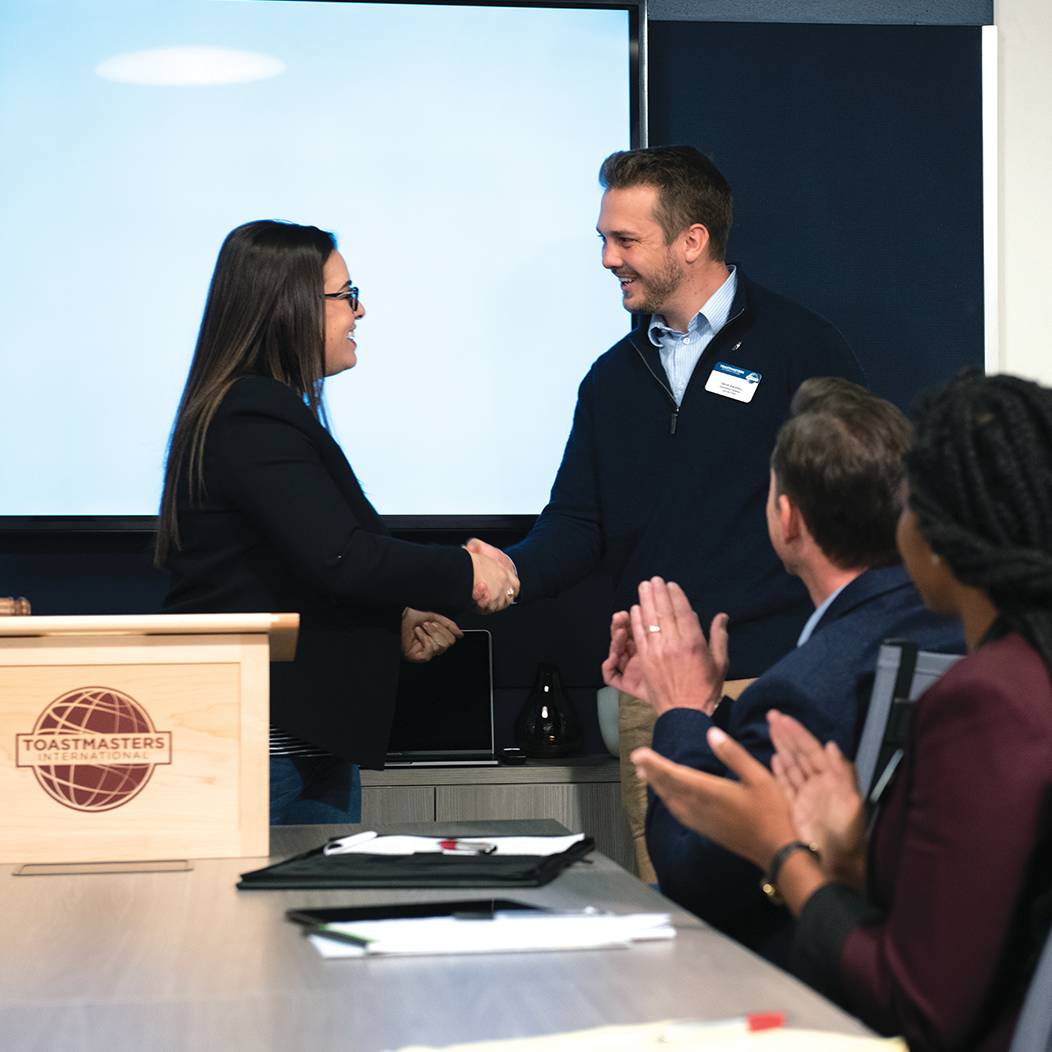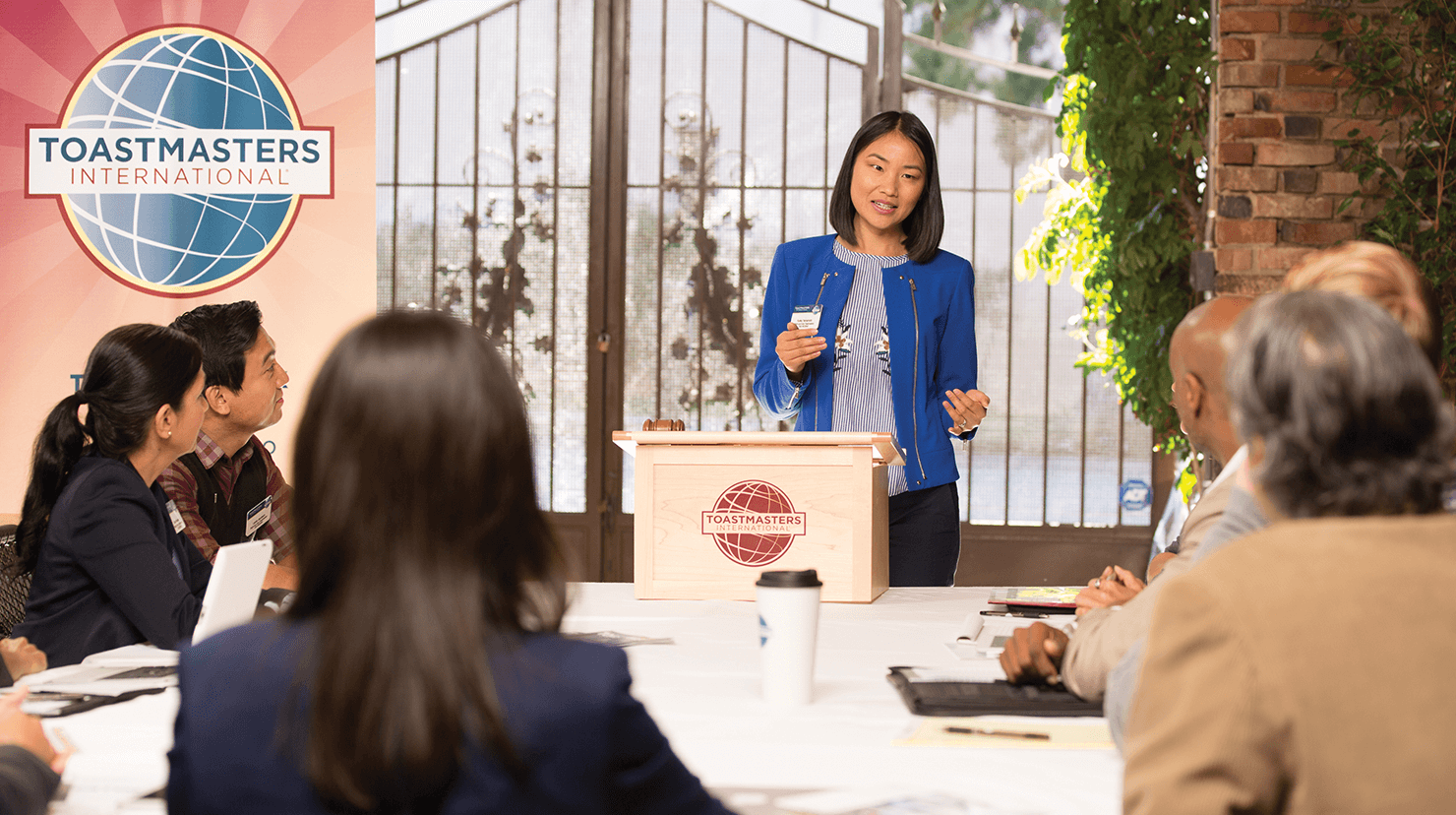The core of every member’s Toastmasters experience is the club meeting. We all share the common thread of Table Topics, prepared speeches and evaluations, yet clubs structure their meetings in different ways. Consider these tips from veteran club leaders, who are experts at holding well-run and productive meetings. They know how to maximize members’ time, help them reach their goals and maintain a vital meeting culture.
Manage Time Well
“My mantra has always been to get the basics right,” says Marc Lottig, DTM, co-founder of City Limits Toastmasters in London, England. However, a typical challenge facing clubs is time management, he adds.
1 Allocate Enough Time.
Too often members create meeting agendas with unrealistic time slots, forgetting about introductions and transitions. As an example, says Lottig, members may allocate nine minutes for three evaluations and believe that’s enough, since evaluations typically last two to three minutes; however, it’s important to factor in the 30-second grace period allowed for each evaluation if the evaluator exceeds the three-minute limit. Time is also needed to introduce each evaluator and allow for the member walking to the front of the room and back. That results in at least four minutes per evaluation and maybe more.
The same holds true for prepared speeches and Table Topics. Without accounting for the actual time needed for each session, meetings will run overtime or be rushed.
At London’s City Limits, agendas are set with those allocations in mind. As a result, meetings finish on time or even early. “The psychological effect is that all attendees believe it is a well-managed meeting,” says Lottig, “which adds to the subjective sense of joint accomplishment. It makes everyone feel that their time is valued.”
2 Have a Five-Minute Plan.
“Always start on time, even if hardly anyone is there,” says Agnes Boskovitz, DTM, from the University Toastmasters club in Canberra, Australia, and the online advanced club Firebirds Collective Toastmasters.
“A club does not become the best in its district by accident.”
—ANDRÉ LINS DE ALBUQUERQUE, DTMBoskovitz asks the main role players to arrive early and lines up substitutes for anyone on the agenda who hasn’t arrived five minutes before the meeting starts. If a speaker fails to appear, she has a list of educational and fun activities ready to fill the time, such as impromptu debates and dramatic readings.

3 Be Strategic with Announcements.
Some clubs start meetings with announcements, which can bog things down and steal time from the education section. To counter this, the University Toastmasters moved announcements to the middle of its one-hour meeting. Now members pay more attention during announcements and the meeting keeps moving. Some clubs save announcements for the end of the meeting to ensure the education portion receives the most attention and the business portion is focused.
Maximize Member Speaking Opportunities
At each meeting, try to provide a speaking opportunity for every member in attendance. You will challenge members, keep their momentum going and help them develop their skills and confidence.
1 Assign Table Topics.
Many clubs ask for volunteers to answer Table Topics. Too often, only confident or risk-taking members will try. Instead, follow Toastmasters’ guidelines and assign topics by reading the question first, so everyone starts to think of an answer, and then calling on a member to present.
Ideally, only members who don’t have a speaking role on the agenda will be called. Boskovitz recommends Table Topicsmasters write down the names of members in attendance who don’t have a role to ensure each is given a topic.
She also advises not to offer topics to guests until all members have spoken. “Whilst it might seem hospitable and encouraging to offer guests an opportunity,” says Boskovitz, “our first priority is to our members, whom we would be sad to lose and who have, in fact, paid real money for the Toastmasters experience.”
2 Work with Members Individually.
To ensure members are moving forward in their educational journey, track their participation to include speeches and meeting roles. By doing so, the Vice President Education (VPE) can monitor member engagement and approach individuals who haven’t signed up for a role in a while or continue to fill the same role, time and time again.
Consider creating a shared online document that everyone can view and update. This helps maintain accurate tracking without overburdening the VPE. It can also serve as motivation. “This will excite members about their achievement and inspire others to do the same,” says Dr. Yvonne Leong, DTM, 2018–2019 Program Quality Director for District 102 in Malaysia. “It can also be kept as a record for future references.”
Tracking can also help you get new members on the schedule quickly. Don’t assume new members will volunteer to sign up for a meeting role.
If you’re seeking input from members about the club or any of its activities, it also helps to request feedback in one-on-one sessions. What people are willing to say in front of a group and in a one-on-one chat could be very different.
3 Provide More Opportunities.
If your club membership is so large that attendance far outweighs the opportunities for consistent participation, consider holding more meetings. You want to avoid members becoming frustrated with the lack of opportunities. Some clubs schedule meetings twice a week at different times of the day to provide options. Holding Speak-a-thons can also help clubs with more speakers than meeting slots.
One of the best ways to learn about best practices in club meetings is to visit other clubs.
Members can also present at other clubs, which can test speakers with a new audience and help a club that might need more roles filled. If your club grows too big, it may be time to split into two.
Mentors Matter
“The real leader is the one who forms other leaders,” says André Lins de Albuquerque, DTM, member of Rio Toastmasters in Rio de Janeiro, Brazil, and 2018–2019 Club Growth Director for District 111. A mentoring program, or other systems of formalized support, can be a great asset for clubs.
1 Provide Support to Members.
Mentoring programs help new members understand and work within the Toastmasters program. Mentors can also explain meeting-role requirements, which can involve more duties than expected and are crucial to a positive learning experience. Mentors can also help experienced members who wish to try something new, such as participating in a speech contest for the first time or running for a district-level office.

Participants in new clubs can benefit too. Even if everyone is new, a “buddy system” can provide a structure for motivating and supporting each other and holding each other accountable for their goals.
2 Offer Buddies to Guests.
Members aren’t the only ones who can benefit from experienced guides in Toastmasters. Guests can too. “Greeting visitors can be sloppy at some clubs,” says Judith Taylor, DTM, of UWP Toastmasters in Johannesburg, South Africa. It’s important to have a system to shepherd guests through the meeting. Buddies can be there for guests from the initial welcome through the meeting itself to the follow-up. If you designate someone for each visitor, there’s a better chance the guest will join the club as a result of feeling a connection.
Reach Outside the Club
You’re not limited to resources within your own club. With more than 16,600 clubs in 143 countries, there are other Toastmasters available to help.
1 Visit Other Clubs.
One of the best ways to learn about best practices in club meetings is to visit other clubs. While the Toastmasters program is the same worldwide, it’s instructive to see the way other clubs organize the experience. Plus, every club’s culture is different. Seeing how others approach a meeting can confirm what is working well for your own club and provide ideas for improvements.
“Visiting other clubs also increases your observation and listening skills,” says Taylor. “Plus, it extends your Toastmasters network.”
2 Invite Others In.
Another way to expose the club to other practices is to invite experienced members from other clubs to speak or serve in meeting roles, particularly General Evaluator. “General Evaluators are not used as much as they could be,” says Taylor. Gaining an outside perspective about the meeting can shed light on issues the club is not considering.
Another option is to invite an experienced Toastmaster to attend and provide feedback to the president or executive committee separately. If you don’t know any experienced members from other clubs, contact your area director or other district-level officers for help.
“A club does not become the best in its district by accident,” says Lins de Albuquerque. Try these tips for productive meetings to ensure your club is doing all that it can to help members strengthen skills, achieve goals and advance on their Toastmasters path.
Do you want to show friends, colleagues and prospective members what happens at a Toastmasters club meeting? Share the video below!
Jennifer L Blanck, DTM has more than 25 years of career development and advising experience. She is a member of 5-Star Toastmasters Club in Arlington, Virginia, and AAMC Toastmasters in Washington, D.C., as well as a regular contributor to the Toastmaster magazine. Learn more at jenniferlblanck.com



 Previous
Previous
 Keeping Time
Keeping Time
 Previous Article
Previous Article

